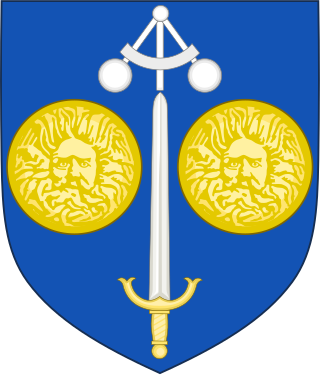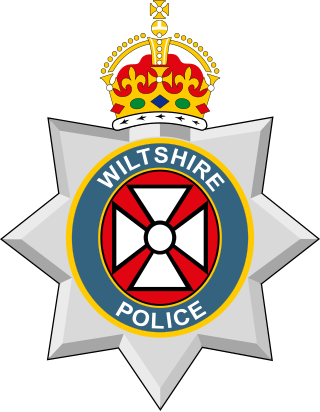
Swindon is a large town in Wiltshire, England. At the time of the 2021 Census the population of the borough was 233,400, making it the largest settlement in the county. Located in South West England, Swindon lies on the M4 corridor, 71 miles to the west of London and 36 miles to the east of Bristol. The Cotswolds lie just to the town's north and the North Wessex Downs to its south.

Swindon Town Football Club is a professional football club based in Swindon, Wiltshire, England. The team, known as the "Robins", currently compete in EFL League Two, the fourth tier of the English football league system; their home colours are red and white. Since 1896 the club has played home matches at the County Ground, which now has a capacity of 15,547. Hall of Fame inductee John Trollope played 770 league games for the club between 1960 and 1980, a professional record in English football.

The Wilts & Berks Canal is a canal in the historic counties of Wiltshire and Berkshire, England, linking the Kennet and Avon Canal at Semington near Melksham, to the River Thames at Abingdon. The North Wilts Canal merged with it to become a branch to the Thames and Severn Canal at Latton near Cricklade. Among professional trades boatmen, the canal was nicknamed the Ippey Cut, possibly short for Chippenham.

The University of Bath is a public research university in Bath, England. It received its royal charter in 1966, along with a number of other institutions following the Robbins Report. Like the University of Bristol and University of the West of England, Bath can trace its roots to the Merchant Venturers' Technical College, established in Bristol as a school in 1595 by the Society of Merchant Venturers. The university's main campus is located on Claverton Down, a site overlooking the UNESCO World Heritage city of Bath, and was purpose-built, constructed from 1964 in the modernist style of the time.

Chippenham is a market town in northwest Wiltshire, England. It lies 13 miles (21 km) northeast of Bath, 86 miles (138 km) west of London, and is near the Cotswolds Area of Natural Beauty. The town was established on a crossing of the River Avon and some form of settlement is believed to have existed there since before Roman times. It was a royal vill, and probably a royal hunting lodge, under Alfred the Great. The town continued to grow when the Great Western Railway arrived in 1841. The town had a population of 36,548 in 2021.

A blue plaque is a permanent sign installed in a public place in the United Kingdom and elsewhere to commemorate a link between that location and a famous person, event, or former building on the site, serving as a historical marker. The term is used in the United Kingdom in two different senses. It may be used narrowly and specifically to refer to the "official" scheme administered by English Heritage, and currently restricted to sites within Greater London; or it may be used less formally to encompass a number of similar schemes administered by organisations throughout the UK. The plaques erected are made in a variety of designs, shapes, materials and colours: some are blue, others are not. However, the term "blue plaque" is often used informally to encompass all such schemes.

Harlow is a large town and local government district located in the west of Essex, England. Founded as a new town, it is situated on the border with Hertfordshire and London, Harlow occupies a large area of land on the south bank of the upper Stort Valley, which has been made navigable through other towns and features a canal section near its watermill. Old Harlow is a historic village founded by the early medieval age and most of its high street buildings are early Victorian and residential, mostly protected by one of the Conservation Areas in the district. In Old Harlow is a field named Harlowbury, a de-settled monastic area which has the remains of a chapel, a scheduled ancient monument.

Oxford Brookes University is a public university in Oxford, England. It is a new university, having received university status through the Further and Higher Education Act 1992. The university was named after its first principal, John Henry Brookes, who played a major role in the development of the institution.

The Civic Trust of England was a charitable organisation founded in 1957. It ceased operations in 2009 and went into administration due to lack of funds.

Crystal Palace Park is a large park in south-east London, Grade II* listed on the Register of Historic Parks and Gardens. It was laid out in the 1850s as a pleasure ground, centred around the re-location of The Crystal Palace -- the largest glass building of the time -- from central London to this area on the border of Kent and Surrey; the suburb that grew around the park is known by the same name.

Coate Water is a country park situated 5 km (3.1 mi) to the southeast of central Swindon, England, near junction 15 of the M4. It takes its name from its main feature, a reservoir originally built to provide water for the Wilts & Berks Canal. Now named 'Coate Water Country Park', the lake and its surroundings are both a leisure facility and a nature reserve.

Wiltshire Police, formerly known as Wiltshire Constabulary, is the territorial police force responsible for policing the county of Wiltshire in South West England.
The Swindon Advertiser is a daily tabloid newspaper, published in Swindon. The newspaper was founded in 1854, and had an audited average daily circulation at the end of 2017 of 8,828.

Swindon is a town in Wiltshire in the South West of England. People have lived in the town since the Bronze Age and the town's location, being approximately halfway between Bristol and London, made it an ideal location for the Locomotive Factories of the Great Western Railway in the 19th century.

Swindon FM was a local DAB radio station broadcasting to the English town of Swindon between 2003 and 2006, after making two trial FM broadcasts in 2001 and 2002. The station stopped broadcasting in May 2006.
New College is a further and higher education institution in Swindon, Wiltshire, England. There are two main campuses, Queens Drive and North Star, as well as an Adult Learning Centre in Swindon town centre.

Leeds Civic Trust is a voluntary organisation and registered charity established in Leeds, West Yorkshire, England in 1965. Affiliated to the national charity Civic Voice, its stated purpose is "to stimulate public interest in and care for the beauty, history, and character of the city and locality, to encourage high standards of design, architecture and town planning; [and] to encourage the development and improvement of features of general public amenity".
Swindon Academy is a non-selective co-educational school within the English academy programme, in the Pinehurst area of Swindon, north of the town centre. It caters for children aged 3 to 19 and has 1,769 pupils on roll as of January 2020.
War Memorials Trust works for the protection and conservation of war memorials in the UK. The charity provides free information and advice as well as administering grant schemes for the repair and conservation of war memorials.

Day House Lane Stone Circle, also known as Coate Stone Circle, is a stone circle near the hamlet of Coate, now on the southeastern edge of Swindon, in the English county of Wiltshire. The ring was part of a tradition of stone circle construction that spread throughout much of Britain, Ireland, and Brittany during the Late Neolithic and Early Bronze Age, over a period between 3300 and 900 BCE. The purpose of such monuments is unknown, although some archaeologists speculate that the stones represented supernatural entities for the circle's builders.